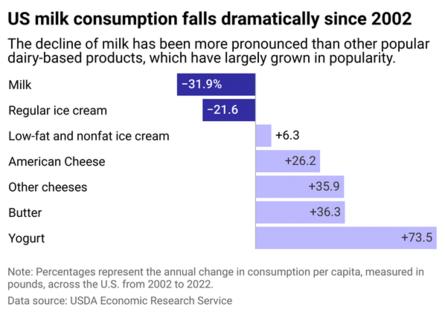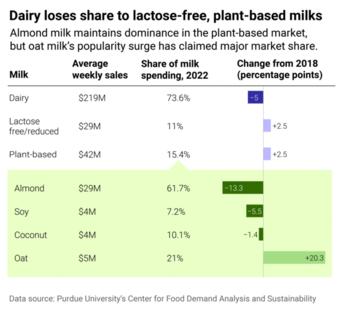The 'Got Milk?' era has given way to plant-based alternatives. Here's why.
Published in Slideshow World
Subscribe
The 'Got Milk?' era has given way to plant-based alternatives. Here's why.
In 1993, up-and-coming Hollywood director Michael Bay created a formative piece of '90s pop culture: the very first "Got Milk?" television commercial.
The iconic ad occurs inside a dimly lit Alexander Hamilton museum, where actor Sean Whalen spreads goopy peanut butter over slices of bread. As he subsequently scarfs down his sandwich, he overhears a radio contest promising $10,000 to the caller able to name the man who challenged Hamilton to a duel. Knowing the answer, he grabs the phone and yells, "Aaron Burr!" but his sticky mouth garbles the words. In the final seconds, Whalen hastily grabs a nearby milk carton only to find a few measly drops left in his glass. The ad finishes with a two-word stinger that would soon become a staple in the cultural lexicon: "Got milk?"
Indeed, almost anyone who grew up in the '90s remembers the ubiquitous milk-drinking ad campaign (funded by the California Milk Processor Board), which, in addition to various commercials, featured billboards and photos of celebrities and athletes (everyone from Harrison Ford to tennis star sisters Serena and Venus Williams) smiling into the camera with milk-stained mustaches.
At the time, milk was extolled for building strong bones and essential in public school lunch programs; its consumption was included in the Centers for Disease Control and Prevention's Youth Risk Behavior survey; and the Department of Agriculture still recommends children ages 9 to 13 consume 3 cups of dairy each day, which could also include yogurt, soy milk, and cheese.
Still, while dairy provides nutritional benefits (including calcium, vitamin D, and phosphorus) and the "Got Milk?" campaign (discontinued in 2014) is considered one of the best of all time, milk consumption has declined in recent decades. By 2022, Americans consumed 130 pounds of milk per capita, which might sound like a lot, but that's down substantially from 196 pounds in 2000 and 247 pounds in 1975. That can be attributed to various factors, including dietary trends, health concerns, environmental awareness, and the rise of plant-based milks, despite their differing nutritional value compared to dairy.
To explore this evolution further, VNutrition analyzed the fall of milk and the rise of plant-based alternatives, using data from the Economic Research Service and Purdue University's Center for Food Demand Analysis and Sustainability.
Visit thestacker.com for similar lists and stories.
Milk consumption falls faster than other dairy products
To understand how much dairy milk consumption has declined, you have to compare it to the intake of other dairy food items. Besides regular ice cream (and smaller subcategories like frozen yogurt, sherbet, and cottage cheese), milk is the only dairy product that hasn't grown in popularity. In fact, despite being a grocery staple in the U.S., the per capita consumption of fluid milk has decreased over the last seven decades, falling at its fastest rate throughout the 2010s.
Much of that can be attributed to generational differences. A 2013 Economic Research Service report noted that individuals born in the 1970s drank less milk in their teens, 20s, and 30s than individuals at the same age intervals born in the 1960s. The same findings occurred for those born in the '80s and '90s. According to the CDC, in 1999, about 18% of high school students nationwide had drunk three or more glasses of milk per day, but by 2019, that number dropped to 7%.
As a result, about 90% of the U.S. population doesn't meet federal dietary recommendations for dairy consumption (2- to 3 cup-equivalents of dairy products per day). The decline parallels an increasing trend in youth forgoing breakfast, where milk is often consumed in coffees, teas, and cereals. (Seventeen percent of high school students don't eat breakfast every day). Still, it's important to consider other factors—including lactose intolerance, milk allergies, and environmental concerns—as reasons for the decline.
According to the National Institutes of Health, lactose intolerance affects approximately 65% of the global population, contributing to more awareness about lactose malabsorption. Meanwhile, dairy production has had an increasingly considerable effect on climate change due to greenhouse gas emissions from feed production and poor handling of manure.
In an August 2018 survey, market research firm Mintel found that nearly half of internet users over the age of 18 "worried about the environmental impact of dairy production," while close to a third of the same consumers said they would "pay more for cheese made with milk from 'free-range' cows." The shift in dairy consumption, especially among younger generations, has played a large role in the emergence of plant-based products, providing healthier and more environmentally-conscious alternatives.
As cow's milk consumption declines, alternative milks become more popular
When Wendy Liberkus grew up in the 1960s and '70s, she didn't realize she was lactose intolerant. Every day, she drank her school's required milk with her hot lunch, "and then I would have stomach issues five days a week," she told Stacker. As she became more aware of her dietary issues and eventually left home to attend college, she vowed to stop eating and drinking animal-based products, switched to plant-based milks she found at the health store, and saw a major difference in her overall lifestyle.
"I take no medications, and I have more energy than anybody you'll meet," Liberkus said. "Plant-based is part of what's helped keep me healthy."
Now a newly retired 60-year-old residing in Las Vegas, Liberkus recently purchased a machine that can take rice, rolled oats, uncooked soybeans, raw almonds, pistachios, or cashews and produce milk with them. It's also helped her avoid cholesterol and saturated fats—and lowered her grocery bill too. "I use everything that's organic, I filter my water, and then I can add sweetener or flavor if I want," she said. "Now that I have a little more time, I can kind of intentionally start to think and work more on this kind of stuff that will obviously help your body and help you feel better."
Liberkus represents a growing swath of consumers who have switched to drinking plant-based milks for health-related purposes. Though dairy milk is still the leader in consumption (in 2022, almost three-quarters of milk product expenditures belonged to regular dairy milk), nondairy alternatives have taken away some of dairy milk's market share. Over the last few years, Americans have spent nearly $3 billion annually on plant-based milks, which primarily include soy, almond, coconut, and oat, with the latter seeing the highest spike in popularity between 2018 and 2022.
Want more proof of its growing popularity? In November 2024, Starbucks announced that it was removing extra charges for nondairy milk for customers in the U.S. and Canada.
Many plant-based milks have the same micronutrient profiles as dairy milk, are lower in cholesterol and saturated fats, and are rich in essential nutrients like vitamins, minerals, and antioxidants. This has appealed to consumers looking to live healthier, cleaner, and vegan lifestyles while supporting the 95% of consumers trying to be more environmentally conscious.
Still, besides having a nontraditional taste, plant-based alternatives aren't as nutritious as cow's milk, at least according to a 2024 study from the Journal of the Academy of Nutrition and Dietetics, which analyzed the makeup of 219 plant-based milks. The study found that plant-based milks were typically lower in protein with a variety of added sugars, but experts advocate checking nutritional labels to understand what type of plant-based product is right for your health needs.
With no real signs of plant-based milk (and even lactose-free milk) consumption slowing down (at least outside of inflation), it's expected that cow's milk alternatives will account for 30% of milk sales nationwide by 2026, according to projections by Mintel.
Not even a new celebrity-endorsed "Got Milk?" ad can curtail that trend.
Story editing by Carren Jao. Additional editing by Kelly Glass. Copy editing by Paris Close.
This story originally appeared on VNutrition and was produced and distributed in partnership with Stacker Studio.









Comments